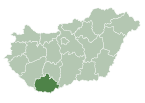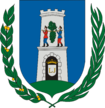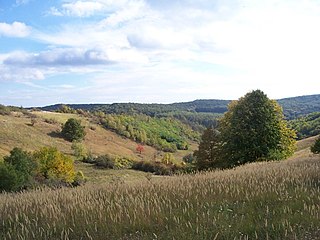
Baranya is a county in southern Hungary. It is part of the Southern Transdanubia statistical region and the historical Baranya region, which was a county (comitatus) in the Kingdom of Hungary dating back to the 11th century. Its current status as one of the 19 counties of Hungary was established in 1950 as part of wider Soviet administrative territorial reform following World War II. It is bordered by Somogy County to the northwest, Tolna County to the north, Bács-Kiskun County and the Danube to the east, and the border with Croatia to the south.

Somogy is an administrative county in present Hungary, and also in the former Kingdom of Hungary.

Baranya or Baranja is a geographical and historical region between the Danube and the Drava rivers located in the Pannonian Plain. Its territory is divided between Hungary and Croatia. In Hungary, the region is included in Baranya county, while in Croatia, it is part of Osijek-Baranja county.

Baranya was an administrative county (comitatus) of the Kingdom of Hungary. Its territory is now divided between present-day Baranya County of Hungary and Osijek-Baranja County of Croatia. The capital of the county was Pécs.

Mohács is a town in Baranya County, Hungary, on the right bank of the Danube.

Swabian Turkey is a term describing a southwestern region of Hungary delimited by the Danube and Drava rivers, inhabited by the Germans of Hungary, an ethnic German minority. This modern-day minority, the largest German-speaking one in Hungary, primarily lives in the counties of Tolna, Baranya, and Somogy, and is the largest population of the Danube Swabians (Donauschwaben). Despite the name, virtually no ethnic Turks live in the region; rather, the name refers to the area being formerly Turkish (Ottoman) territory before being repopulated by Germans ("Swabians").

Somogy was an administrative county (comitatus) of the Kingdom of Hungary. Its territory, which was slightly larger than that of present Somogy county, is now in south-western Hungary. The capital of the county was Kaposvár.

Ecseny is a village in Somogy county, Hungary.
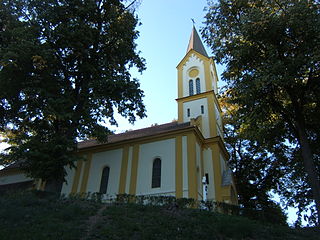
Kercseliget is a village in Somogy County, southern Hungary.

Potony is a village in Somogy County, Hungary.

Nágocs is a village in Somogy County, Hungary. Jutom-puszta, Csillag-puszta, Tomé-puszta and Kovászna are all parts of Nágocs.

Szentborbás is the southernmost village of Somogy county, Hungary. Krancsevicza-puszta is part of the village.

Abaliget is a village in central Baranya County, Pécs District, in southern Hungary. Until the end of World War II, the inhabitants' majority was Danube Swabian, also called locally as Stifolder, because their ancestors arrived in the 17th and 18th centuries from Fulda (district). Most of the former German settlers were expelled to Allied-occupied Germany and Allied-occupied Austria in 1945–1948, pursuant to the Potsdam Agreement. Only a few Germans of Hungary live there, the majority today are the descendants of Hungarians from the Czechoslovak–Hungarian population exchange. They got the houses of the former Danube Swabian inhabitants. It is located in the western Mecsek Mountains. The nearby Abaliget Cave and the area's lakes and hiking trails make it a popular tourist destination. Its population at the 2011 Census was 598.

Babarc is a village and municipality in Baranya county, Hungary. Until the end of World War II, the inhabitants were Danube Swabians, also called locally as Stifolder, because their ancestors were from Fulda (district). Most of the former German settlers were expelled to Germany and Austria in 1945–1948, as a result of the Potsdam Agreement. Only a few Germans of Hungary live there, the majority today are the descendants of Hungarians from the Czechoslovak–Hungarian population exchange. They occupied the houses of the former Danube Swabian inhabitants.

Bisse is a village in Baranya county, Hungary.
Ág is a village in northern Baranya County, Hegyhát District, in southern Hungary. Its population at the 2011 Census was 177. Until the end of World War II, the inhabitants' majority was Protestant Danube Swabians. Most of the former German settlers were expelled to Allied-occupied Germany and Allied-occupied Austria in 1945–1948, following the Potsdam Agreement. Only a few Germans of Hungary live there, the majority today are the descendants of Hungarians from the Czechoslovak–Hungarian population exchange. They got the houses of the former Danube Swabian inhabitants.

Bogdása is a village in Baranya County, in Sellye District, west of Sellye, in the neighbourhood of Drávafok.

Kisbudmér is a village and municipality in Baranya county, Hungary.
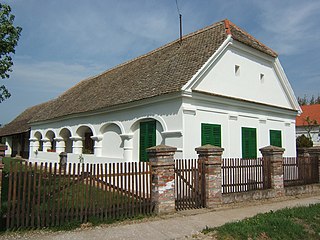
Patapoklosi is a village in Szigetvár district, in Baranya county, Hungary.
Szentlászló is a village in Baranya county, Hungary.

















